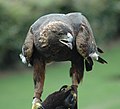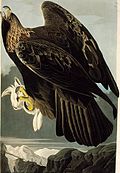Difference between revisions of "Field Guide/Birds/Aquila chrysaetos"
| Line 37: | Line 37: | ||
There was a great decline in [[Central Europe]], and the Golden Eagle is now restricted to the higher central Appennine regions of Italy (the regional capital of [[Abruzzo]] is named after the Latin/Italian word for eagle, [[L'Aquila]]), and the [[Alps]]. In [[Britain]], there are about 420 pairs left in the [[Scottish highlands]], and between [[1969]] and [[2004]] they bred in the English [[Lake District]]. In [[North America]] the situation is not as dramatic, but there has still been a noticeable decline. | There was a great decline in [[Central Europe]], and the Golden Eagle is now restricted to the higher central Appennine regions of Italy (the regional capital of [[Abruzzo]] is named after the Latin/Italian word for eagle, [[L'Aquila]]), and the [[Alps]]. In [[Britain]], there are about 420 pairs left in the [[Scottish highlands]], and between [[1969]] and [[2004]] they bred in the English [[Lake District]]. In [[North America]] the situation is not as dramatic, but there has still been a noticeable decline. | ||
| − | Efforts are being made to re-introduce the species in [[Glenveagh National Park]], [[County Donegal]], [[Ireland]], where they had been extinct since the early 20th Century. Forty-six birds have been released into the wild from 2001 to 2006, with at least three known female fatalities since then. | + | Efforts are being made to re-introduce the species in [[Glenveagh National Park]], [[County Donegal]], [[Ireland]], where they had been extinct since the early 20th Century. Forty-six birds have been released into the wild from 2001 to 2006, with at least three known female fatalities since then. |
| + | total of sixty birds, to ensure a viable population. | ||
== Reproduction == | == Reproduction == | ||
Revision as of 22:35, 9 March 2007
Template:Otheruses Template:Taxobox The Golden Eagle (Aquila chrysaetos) is one of the best known birds of prey in the Northern Hemisphere. Like all eagles, it belongs to the family Accipitridae.
There are six subspecies of Golden Eagle that differ slightly in size and plumage. They can be found in different parts of the world:
- A. c. chrysaetos: Eurasia except Iberian peninsula, east to western Siberia.
- A. c. canadensis: North America.
- A. c. homeryi: Iberian peninsula and North Africa, east to Turkey and Iran.
- A. c. japonica: Japan and Korea.
- A. c. daphanea: From southern Kazakhstan east to Manchuria and south-west China including northern India and Pakistan.
- A. c. kamtschatica: Eastern Siberia, from the Altay to the Kamchatka Peninsula.
Golden Eagles are renowned for their striking appearance and combining power with agility in flight.
Distribution
At one time, the Golden Eagle lived in temperate Europe, North Asia, North America, North Africa and Japan. In most areas this bird is now a mountain-dweller, but in former centuries it also bred in the plains and the forests. In recent years it has started to breed in lowland areas again (Sweden, Denmark).
There was a great decline in Central Europe, and the Golden Eagle is now restricted to the higher central Appennine regions of Italy (the regional capital of Abruzzo is named after the Latin/Italian word for eagle, L'Aquila), and the Alps. In Britain, there are about 420 pairs left in the Scottish highlands, and between 1969 and 2004 they bred in the English Lake District. In North America the situation is not as dramatic, but there has still been a noticeable decline.
Efforts are being made to re-introduce the species in Glenveagh National Park, County Donegal, Ireland, where they had been extinct since the early 20th Century. Forty-six birds have been released into the wild from 2001 to 2006, with at least three known female fatalities since then.
total of sixty birds, to ensure a viable population.
Reproduction
A pair of Golden Eagles remains together for life. They build several eyries within their territory and use them alternately for several years. The nest consists of heavy tree branches, upholstered with grass.
Old eyries may be 2 metres (6.6 ft) in diameter and 1 metre (3.3 ft) in height, as the eagles enlarge their nests every year. If the eyrie is situated on a tree, supporting tree branches may break because of the weight of the nest.
The female lays two eggs between January and May (depending on the area). After 45 days the young hatch. They are entirely white and are fed for fifty days before they are able to make their first flight attempts and eat on their own. In most cases only the older chick, which takes most of the food, survives, while the younger one dies without leaving the eyrie.
Physical characteristics
Adult Golden Eagles have an average length of 75-85 cm (30-34"), a wingspan of 150-210 cm (59-83"), and a weight of 3-5 kg (7-11 lb). As in all birds of prey, the females are generally slightly larger than the males. The largest golden eagle on record measured 41 inches (103cm) in length and weighed in an excess of 9kg (20.245lb). It was a female found in Spain. She also held the record for the tallest Golden eagle, standing 66 cm (26 inches)Template:Fact. The largest North American Golden Eagle was captured for research in Grand Teton National Park in 2006, with a weight of 8.4kg (18.5lb)Template:Fact. She was caught by researchers Bryan Bedrosian and Tom Rogers working for Beringia South in Kelly, WY. She was determined to be healthy and released.
The plumage colours range from black-brown to dark brown, with a striking golden-buff crown and nape, which give the bird its name. The juveniles resemble the adults, but have a duller more mottled appearance. Also they have a white-banded tail and a white patch at the carpal joint, that gradually disappear with every moult until full adult plumage is reached in the fifth year.
Hunting
Heraldry
Template:Main The Golden Eagle is featured in the national coat of arms of Mexico, Germany, Egypt many other countries
Gallery
Audubon's illustration
References
- Template:IUCN2006 Database entry includes justification for why this species is of least concern
- Cramp, S. and Simmons, KEL(eds) (1980) The Birds of the Western Palearctic Vol. II, Oxford University Press, ISBN 0-19-854099-X
External links
Template:Commons Template:Wikispecies
- Cornell Lab of Ornithology - Species Account
- Golden Eagle Information and Photos
- Golden Eagle InfoCenter
- ARKive - images and movies of the golden eagle (Aquila chrysaetos)
- Access to Eagles and Eagle Parts: Environmental Protection v. Native American Free Exercise of Religion
- Photos Hunting with Golden Eagles
- RSPB A to Z of UK Birds
- AQUILALP.NET - Monitoring Golden Eagles in the Eastern Alps
- Golden Eagle (Aquila chrysaetos) at www.pauldfrost.co.uk/
- Current Research on Golden Eagles
- Picture of Golden Eagle chick in nest
- Picture sequence of Golden Eagle attaching fox
ar:نسر ذهبي bg:Скален орел cs:Orel skalní da:Kongeørn de:Steinadler et:Kaljukotkas es:Aquila chrysaetos eo:Reĝa aglo fr:Aigle royal fy:Keningsearn gl:Aguia real it:Aquila chrysaetos he:עיט זהוב la:Aquila chrysaetos lt:Kilnusis erelis lmo:Aquila Nègra nl:Steenarend ja:イヌワシ no:Kongeørn nn:Kongeørn pl:Orzeł przedni pt:Águia-real ru:Беркут sk:Orol skalný sl:Planinski orel fi:Maakotka sv:Kungsörn ta:பொன்னாங் கழுகு tr:Kaya kartalı





